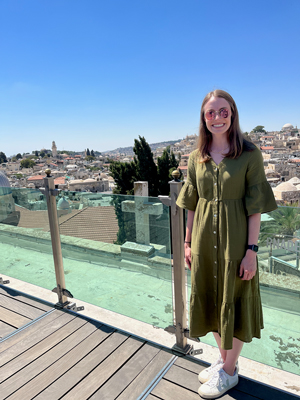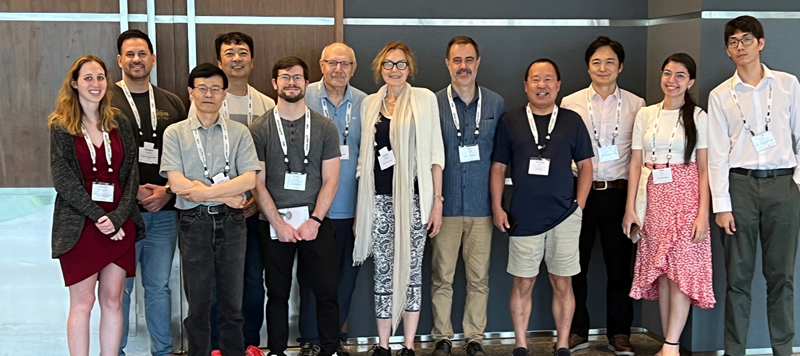News
20232022202120202019
Biochemistry Ph.D Student Madeline Jensen Receives Perfect Score on NIH Fellowship Application
Tuesday, September 5, 2023

Madeline Jensen in Israel in early August
Congratulations to third-year BMB Graduate Student, Madeline Jensen, in getting a fundable score on her NIH F31 submission entitled ‘Identification and structural basis of a potential licensing factor of the Integrator cleavage module’. Ms. Jensen received the top possible score on her application that can be assigned by an NIH review panel. This three-year NIH pre-doctoral fellowship will support her thesis project in the Wagner lab where she will continue her exciting studies of BRAT1, Integrator, and& potential connections to DNA damage. She also recently attended the ‘RNA Summer School’ held in Jerusalem, an NSF-BSF-funded two-week lab-intensive course.
Congratulations Maddie!
UR Center for RNA Biology Members and Alumni Attend RNA 2023 in Singapore
Friday, June 9, 2023

Pictured above, from left to right: Jessica Perciaccante (Genetics Grad Student, Anderson Lab); Douglas Anderson, PhD (Assistant Professor, Medicine, Aab CVRI); Yi-Tao Yu, PhD (Professor of Biochemistry & Biophysics); Xin Li, PhD (former UR Biochemistry & Biophysics Faculty, currently Professor at Zhejiang University); Sean Lindley (Biology Grad Student, Anderson Lab); Eric Phizicky, PhD (Professor of Biochemistry & Biophysics); Lynne Maquat, PhD (Professor of Biochemistry & Biophysics; Director of the UR CRB ); Eric J. Wagner, PhD (Professor of Biochemistry & Biophysics; Associate Director of the UR CRB); Weifeng Gu, PhD (UR Alumn – PhD 2005, currently Assistant Professor, UCR); Tatsuaki Kurosaki, PhD (Research Assistant Professor, Maquat Lab); Sara Ali (Biophysics Grad Student, Mathews Lab), Yi Pan (Biochemistry Grad Student, Yu Lab)
A large number of UR Center for RNA Biology members and alumni attended the 28th Annual RNA Society Meeting (‘RNA 2023’) held at the Suntec Convention Centre from May 30th-June 4th, 2023. In addition to those pictured, Douglas Turner, PhD, Professor Emeritus of the Department of Biochemistry and Member Emeritus of the Center for RNA Biology, attended and received the 2023 The RNA Society/Cold Spring Harbor Laboratory Press Distinguished Research Mentor Award, which recognizes outstanding mentorship by RNA Society members and highlights the importance of fostering the academic and professional development of trainees in RNA research.
Read More: UR Center for RNA Biology Members and Alumni Attend RNA 2023 in SingaporeA Search Engine for mRNA: Algorithm Identifies Optimal Sequences to Improve COVID Vaccines
Friday, May 19, 2023
Messenger RNA vaccines proved their worth in the COVID pandemic, and new software stands to make the already transformative technology even more powerful.
Scientists developed an algorithm to identify the most stable, efficient mRNA sequences for vaccines. Tests show that the algorithm-derived mRNAs resist deterioration longer, produce more COVID spike protein, and dramatically increase antibody levels in mice compared to currently used mRNA vaccines. The results were reported in the journal Nature.
Study authors believe their tool will be valuable to companies that make mRNA vaccines and to research teams developing mRNA-based therapies for genetic disorders, cancer and a plethora of other diseases that can be treated by using mRNA to express a needed protein.
Searching for the Strongest mRNA
The COVID shots given throughout the pandemic have many advantages—scalable production, safety, efficacy—but suffer from some big drawbacks, including the need for ultra-cold storage and the resultant distribution challenges, and waning immunity. These limitations are due to the fact that mRNAs are inherently unstable and prone to degradation (they are constantly being “eaten” by enzymes present in cells).
The “secret sauce” for creating stronger mRNA sequences requires the right balance of two factors: structure and genetic code. Past research shows that mRNAs with a tight, rigid structure, as opposed to a floppy, unconfined structure, degrade more slowly (structure consolidates mRNAs and provides protection from hungry enzymes). Consequently, they stay in cells for a longer period and have more time to make the desired protein.
The mRNA used in COVID vaccines directs our bodies to make the COVID spike protein. The number of mRNA sequences that encode the spike protein is enormous—larger than the number of atoms in the universe. But, some of these genetic instructions are more efficient than others: one set may allow cells to churn out protein more quickly, while a different set might have redundancies that lead to sluggish protein production.
So, how do you find the right combination of structure and code? RNA expert David Mathews, MD, PhD and computer scientist Liang Huang, PhD, collaborated to create an algorithm that assesses both factors. Like a Google search for mRNA sequences, their algorithm spits out the top result for a specific protein amongst the almost infinite number of possibilities.
“Our tool is designed to identify the best sequence out of a huge space that you could never explore experimentally,” said Mathews, co-corresponding author of the Nature study and the Lynne E. Maquat professor of Biochemistry and Biophysics at the University of Rochester Medical Center. “Prior approaches did a poor job of searching this space. We hope this breakthrough will help companies to develop or improve their mRNA therapies.”
Read More: A Search Engine for mRNA: Algorithm Identifies Optimal Sequences to Improve COVID VaccinesDavid Mathews Publishes Study in Nature on Algorithm to Optimize mRNA Vaccines
Thursday, May 4, 2023
The professor of Biochemistry and Biophysics partnered with an Oregon State University computer scientist to develop the algorithm to help research teams find the most stable, efficient mRNA sequences for vaccines and other therapies, such as monoclonal antibodies and anti-cancer drugs. Tested in COVID-19 mRNA vaccines, the algorithm substantially increased protein expression and antibody levels compared to currently used mRNA sequences.
Read More: David Mathews Publishes Study in Nature on Algorithm to Optimize mRNA VaccinesStudy: Yi-Tao Yu, Paul Boutz Harness Power, Precision of RNA to Make Mutations Invisible
Monday, March 6, 2023
Scientists have discovered a new way to suppress mutations that lead to a wide range of genetic disorders. A study in the journal Molecular Cell describes a strategy that co-opts a normal RNA modification process within cells to transform disease genes into normal genes that produce healthy proteins. The findings are significant because they may ultimately help researchers alter the course of devastating disorders such as cystic fibrosis, muscular dystrophy and many forms of cancer.
Negating Nonsense
Around 15 percent of mutations that lead to genetic diseases are called nonsense mutations. Aptly named, nonsense mutations occur when an mRNA molecule contains an early “stop” signal. When the mRNA takes genetic instructions from DNA to create a protein, this early stop sign orders the cell to stop reading the instructions partway through the process. This results in the creation of an incomplete protein that can lead to disease.

Led by Yi-Tao Yu, PhD, a team of researchers from the University of Rochester Center for RNA Biology designed an artificial guide RNA – a piece of RNA that can modify other types of RNA – to target mRNA molecules that contain early stop signals (also called premature termination codons). Guide RNAs are a natural mechanism that cells use all the time; Yu’s team altered this already existing process.
Like DNA, RNA is made up of molecular building blocks that are represented by the letters A (adenine), G (guanine), U (uracil), and C (cytosine). Premature termination codons always have the building block U in the first position (for example, UAG, UAA or UGA). The team’s artificial guide RNA was designed to modify the U in the first position, changing the molecular makeup of the targeted mRNA so that the stop signal is no longer – or less well – recognized by the cell.
Read More: Study: Yi-Tao Yu, Paul Boutz Harness Power, Precision of RNA to Make Mutations InvisibleIron & the brain: Where and when neurodevelopmental disabilities may begin during pregnancy
Monday, March 6, 2023
Study finds possible cellular origin for impairments associated with gestational iron deficiency
The cells that make up the human brain begin developing long before the physical shape of the brain has formed. This early organizing of a network of cells plays a major role in brain health throughout the course of a lifetime. Numerous studies have found that mothers with low iron levels during pregnancy have a higher risk of giving birth to a child that develops cognitive impairments like autism, attention deficit syndrome, and learning disabilities. However, iron deficiency is still prevalent in pregnant mothers and young children.
The mechanisms by which gestational iron deficiency (GID) contributes to cognitive impairment are not fully understood. The laboratory of Margot Mayer- Proschel, PhD, a professor of Biomedical Genetics and Neuroscience at the University of Rochester Medical Center, was the first to demonstrated that the brains of animals born to iron-deficient mice react abnormally to excitatory brain stimuli, and that iron supplements giving at birth does not restore functional impairment that appears later in life. Most recently, her lab has made a significant progress in the quest to find the cellular origin of the impairment and have identified a new embryonic neuronal progenitor cell target for GID. This study was recently published in the journal Development.
“We are very excited by this finding,” Mayer-Proschel said, who was awarded a $2 million grant from the National Institute of Child Health & Human Development in 2018 to do this work. “This could connect gestational iron deficiency to these very complex disorders. Understanding that connection could lead to changes to healthcare recommendations and potential targets for future therapies.”
Read More: Iron & the brain: Where and when neurodevelopmental disabilities may begin during pregnancyRNA Biologist Lynne Maquat Awarded 2023 Gruber Genetics Prize
Thursday, February 23, 2023
Lynne E. Maquat, PhD, the founding director of the Center for RNA Biology at the University of Rochester, has been awarded the 2023 Gruber Genetics Prize for her discovery of nonsense-mediated mRNA decay or NMD in humans. The Gruber International Prize Program, administered by Yale University, honors scientists from around the world whose groundbreaking work leads to fundamental shifts in knowledge and benefits mankind.
Maquat has spent her career deciphering the many roles that RNA plays in sickness and in health, and is best known for elucidating the complexities of NMD in mammalian cells and human disease. One of the major surveillance systems in the body, NMD protects against mistakes in gene expression by targeting and eliminating deleterious mRNAs that could lead to the production of incomplete and potentially toxic proteins. Maquat’s lab also revealed that NMD helps our cells adjust to changes in development and in their environment, and more rapidly respond to certain stimuli.
“Lynne’s scientific prowess and steadfast commitment to her research is exemplary and has helped catapult the field of RNA biology to the forefront of medicine over the past decade,” said Mark B. Taubman, MD, CEO of the University of Rochester Medical Center and dean of the School of Medicine and Dentistry. “This is an exciting time, as Lynne and other scientists are putting her mechanistic findings related to NMD to use to design treatments. She is incredibly deserving of this honor.”
Read More: RNA Biologist Lynne Maquat Awarded 2023 Gruber Genetics Prize